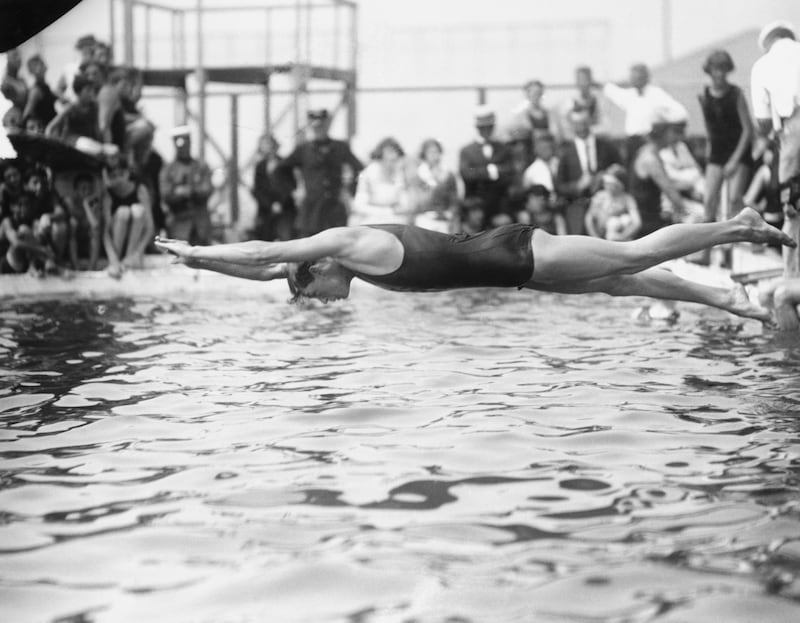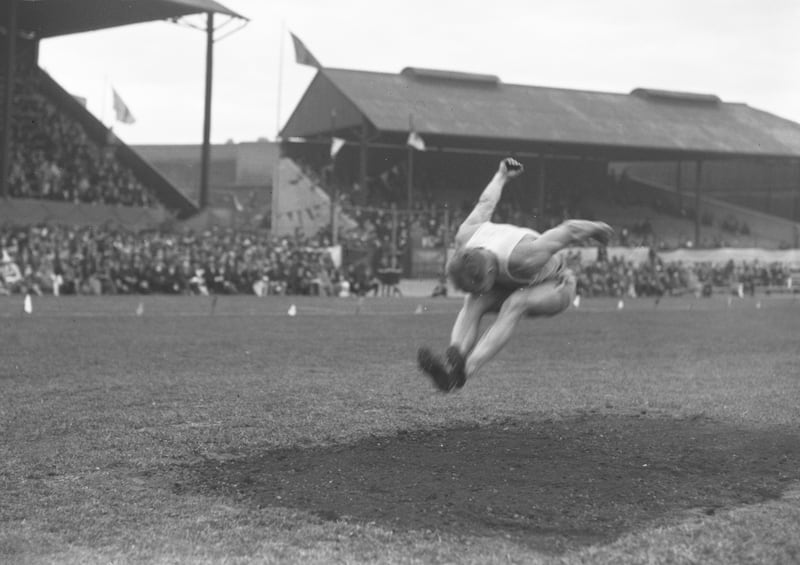This story is part of a series, The Greatest Irish Olympic Stories Never Told, which will run every Saturday in The Irish Times up to the beginning of the 2024 Olympic Games, on Friday, July 26th
In little over two months, the centenary of the Tailteann Games revival will take place. The games were the first big international event to take place in the newly established Free State.
A primary influence on this was James Joseph (JJ) Walsh, who had been chair of the Cork GAA county board, a 1916 participant in the GPO, and later became a Sinn Féin TD.
He was a formidable personality: driven, a brilliant organiser and an ardent separatist, who regarded the GAA as both custodian of the national games and a source of fighting men in the struggle for independence.
READ MORE
Marginally a supporter of the Treaty – as the lesser of two evils – Walsh became postmaster general, later minister for posts and telegraphs, in the first Cumann na nGaedheal government.
He would arrange for all the red Royal Mail postboxes to be repainted green and, more importantly, established 2RN, the radio service that prefigured RTÉ. Again, the GAA influence was apparent as an All-Ireland hurling semi-final between Galway and Kilkenny became in 1926 the first live field sport broadcast in Europe.
Patrick Mehigan – among other things The Irish Times’ first GAA correspondent – was the commentator. A year later, the BBC broadcast its first live coverage of the FA Cup final.
JJ Walsh was appointed director of the Tailteann Games or, in Irish, Aonach Tailteann.
The idea dated from the 1880s and was the brainchild of land reformer and patron of the GAA Michael Davitt, who envisaged “a national festival not only of athletics but also of music and poetry involving the Celtic Race throughout the world.”
Based on the ancient Tailteann Games, held in Tara, between 632 BC and a last recorded reference in 1168, the revival was much influenced by the growing success of the modern Olympics, which also had a role in the first revival 100 years ago.
A revival had been enthusiastically supported by the cabinet of Éamon de Valera before the split; after the split his anti-Treaty Sinn Féin opposed the idea, and it was now pursued by his political opponents when they formed a government.

The Civil War disrupted the timetable that had the Tailteann Games earmarked for 1922, pushing them back by two years.
On the 1922 schedule, the GAA was allocated £10,000 to improve Croke Park, which was to host the opening and closing ceremonies and the athletics events.
After the postponement there were questions in the Dáil about the money that had been granted. Walsh had to defend the grant, which had already been spent, along with a shortfall of £4,000 made up by the GAA. He also had to correct any impression that it was a loan, as referenced by head of government and minister for finance WT Cosgrave.
On November 16th, 1922, Walsh told the Dáil: “When the old Dáil decided on the introduction of the Tailteann Games, the provision of a proper stadium was found necessary. The GAA, as all of you know, suffered very severely during the last three or four years. Its resources have been heavily taxed through matters over which it had no control, and mainly through the fact that its members had been the principal contributors in the fight against England. I think you will all agree with that.
[ Olympic Federation of Ireland to mark centenary of Irish OlympiansOpens in new window ]
“Were it not for these facts I think the ordinary resources of the association would have met this contingency, but it would not have been fair to pledge the future resources of the association for a great programme of this kind, which had only a part bearing on the GAA.
“I do not know that I can quite agree with the president that this sum will have to be paid back by the association. I am afraid we will have a quarrel over this in the future.”
The State would be represented for the first time at an Olympic Games in Paris, 1924. By then the GAA had approved a new Irish athletics body, to be run by a body independent of the association, which had originally included track and field among its sports.
Although the purpose of the Tailteann Games was to be a festival confined to those of Irish heritage, the organisers, aware of the need for something with more box-office appeal and with the Olympics taking place in Paris during the month of July, it was decided to invite some of the Olympics competitors before they travelled home from France, regardless of origin.

Most famously, Johnny Weissmuller, a triple gold medallist in the swimming pool, came to Dublin and competed in a pond in the Phoenix Park and duly won his event before going on to find further fame playing Tarzan in a series of Hollywood films.
The 1924 Olympics are well known in popular culture as the subject of the film Chariots of Fire but none of the story’s protagonists took part in the Dublin games. One gold medallist who did arrive was American Harold Osborn, a double high jump and decathlon winner.
He proved a popular competitor, winning the high jump despite spirited opposition from Larry Stanley, who in Paris became the first athlete to represent Ireland at the Olympics.
A gifted high jumper, who cleared 6ft 3in against Osborn in Dublin, Stanley was also a brilliant footballer who captained Kildare to the 1919 All-Ireland at centrefield. Recalling his football career more than 50 years later, he acknowledged the huge advantage of his dual abilities.
[ Tailteann Games were aimed at ensuring new nation made a splashOpens in new window ]
“I had the natural spring of a high jumper and I could clear over six feet. This obviously gave me a big advantage. I was also quick off the mark having won several prizes over 100 yards, but more than anything else I spent a great deal of time perfecting ball control.”
Another competitor with footballing pedigree was Mayo’s Seán Lavan, widely credited with inventing the solo run. He also represented Ireland in the 1924 and 1928 Olympics and came second in the 400 metres hurdles at the first Tailteann Games.
Osborn was named the best all-round athlete of the games but, having injured himself in the high jump, was unable to take part in the decathlon, prompting his closest competitors, Daniel Kinsey – US gold medallist at the 110m hurdles in Paris – and Ireland’s Bill Shanahan, to try to withdraw from the competition and declare him the winner.
In a script announced by megaphone at the meeting, Osborn expressed his gratitude.
“I now realise what a truly Irish welcome means. I hope to renew acquaintances with the delightful Irish sporting public next summer. Till then – farewell.”
Although about 6,500 competitors took part in various disciplines, including non-elite events, there was no place for soccer, rugby or hockey – the “foreign games” banned by the GAA. At the time there was a division of opinion within the association on this subject but Walsh was a big supporter of the prohibition and his influence was sufficient that the designated sports were excluded.

He didn’t, however, push for a restriction proposed in the Dáil by Labour TD and future ceann comhairle Patrick Hogan, in June 1924. “I think that if the spirit that animated those who took part in these games long ago is to be preserved, if we are to perpetuate that spirit, we should insist on a knowledge of Irish from everybody who takes part in the games.”
Historian Paul Rouse has written extensively on the Tailteann Games. He says that whereas they were a triumph for the fledgling State in 1924, that proved a hard act to maintain.
“The games were such a success in 1924. They attracted great, positive attention to Ireland. The newsreel companies were all here. It was always like the Gathering in the 1920s – scattered tribes coming back to the homeland.
“They didn’t recapture that success in 1928 even though the Olympics were in Europe in Amsterdam, or 1932 when they were in Los Angeles. When De Valera was elected in 1932, he had little enthusiasm for the games. They had become too associated with Cumann na nGaedheal. He did what everyone did to get rid of something: set up an interdepartmental committee, which eventually recommended discontinuing.
“They were also hard going. There was the Paris Olympics 1924, not Paris 1928 and Paris 1932. It’s taken 100 years for the Olympics to go back there. For Ireland to do this, every four years was probably too much.”
Walsh eventually fell out with Cumann na nGaedheal and supported De Valera’s new party Fianna Fáil in 1932. But he was unhappy with the fate of his Tailteann project, writing in his 1944 memoir Recollections of a Rebel that it had been “a deplorable and regrettable mistake”.
He went on to be a successful businessman and industrialist, chairing Clondalkin Paper Mills and being strongly involved in Solus, the Bray company manufacturing light bulbs, among other enterprises, and was elected chair of the Federation of Saorstát Industries.
The most prominent project in his public life will be 100 years old on August 2nd.


















